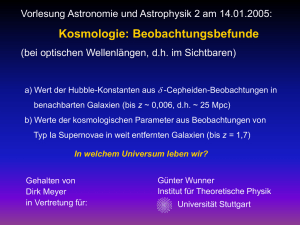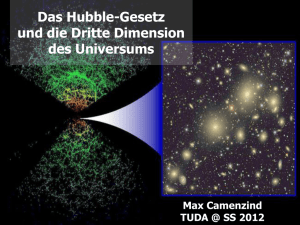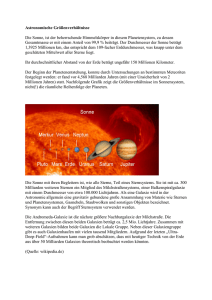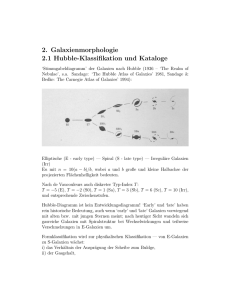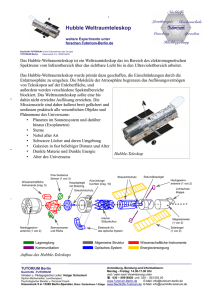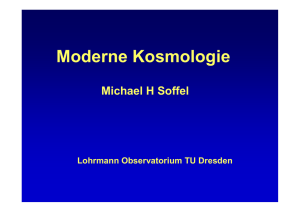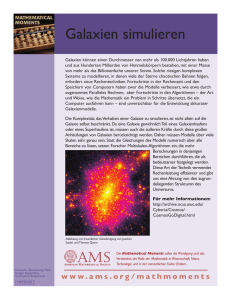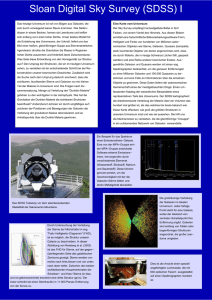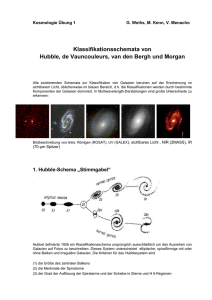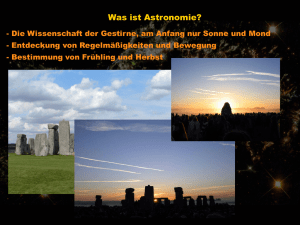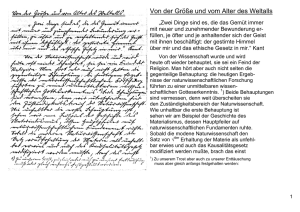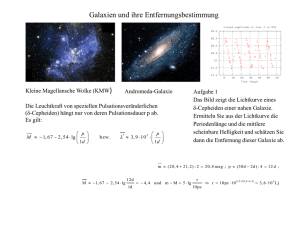Rotverschiebung und Distanzen
Werbung
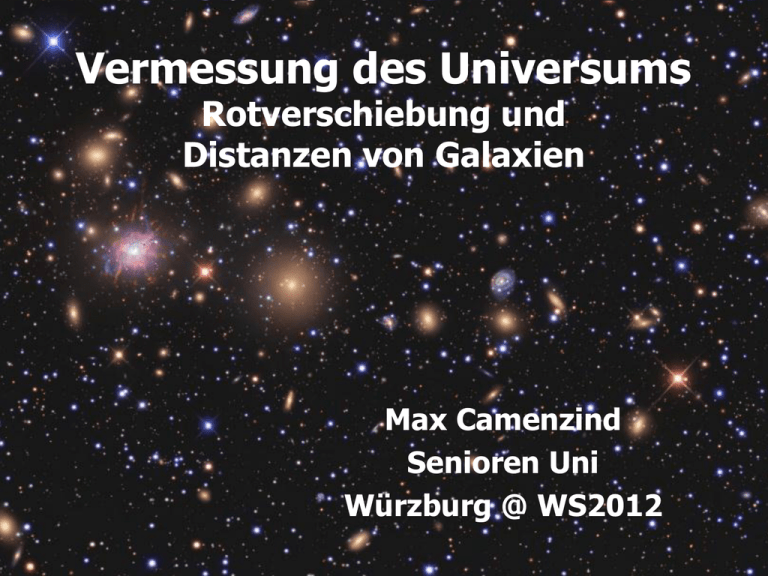
Vermessung des Universums Rotverschiebung und Distanzen von Galaxien Max Camenzind Senioren Uni Würzburg @ WS2012 ESO Hauptquartier ESO La Silla seit Okt. 1962 1. Europäische Südsternwarte Meilensteine der Kosmologie • Aristoteles trennt Physik in „Himmel und Erde“. • 1543: Heliozentrisch Erde rotiert, nicht die Fixsternsphäre, aber immer noch Kreisbahnen. • 1687: Newton führt Gravitationskraft ein gültig im ganzen Universum, noch statisch. • Seit 1920: Teleskope erweitern den Horizont. • 1924: Hubble bestimmt Distanz zu Andromeda. • 1922/1927: Geburt expandierendes Universum • 2004: Hubble Ultra-deep Field Blick ins Universum bis 13 Mrd. Jahre zurück. Distanzen und Rotverschiebung • Wie messe ich die Distanzen zu Andromeda/LMC? 1924 von Edwin Hubble entschieden / 2011 nachgemessen. • Wie messe ich Distanzen zu Galaxien? kosmische Eichkerzen m–M = 5log(d/10 pc) RR Lyrae, Cepheiden und Supernovae Ia. • Was ist kosmische Rotverschiebung? Hubble-Gesetz der Raum expandiert. • Wie bestimme ich die Hubble-Konstante? • Welche Bedeutung hat die Hubble-Konstante? • Kosmische Distanzen Supernovae Ia • Der Cosmic Web – Filamente, Haufen, Voids. Entfernung Andromeda Nebel? Die Shapley-Curtis Debatte von 1920 Curtis Shapley Spiral-Nebel Galaxis Galaxis Die Debatte ergab kein brauchbares Ergebnis! “Questions in science are not resolved by debates, but by observations & experiments” Hubble findet 1924 erste Cepheide V1 Andromeda ist 1 Mio. Lichtjahre entfernt ! Cepheide V1 Hubble hat 1924 die Debatte entschieden mittels Cepheide V1 in M31 “Hubble’s V1 is the most important star in the history of cosmology” Lichtkurve Hubble-Cepheide V1 Shapley: “Here is the letter that destroyed my universe.” 68 Cepheiden in Andromeda Adam G. Riess et al. 2011 arXiv:1110.3769 / HST Moderne Distanz Andromeda Adam G. Riess et al. 2011 arXiv:1110.3769 / HST F160W µ0 = 24,42(0,05) mag D = 765 +/- 28 kpc = 2,5 Mio. Lichtjahre F110W µ = m - M = 5 log(D/10 pc) Unsere Kosmischen Nachbarn 1925 Hubble: Andromeda extragalaktisch Coma-Haufen 100 Mpc Distanzen von Galaxien • Geometrische Distanzen (selten möglich, z.B. Supernova 1987A). • Standard-Kerzen: d² = L / 4p f • Distanzmodul: µ = m – M = 5 log(d/10 pc) • (i) RR-Lyrae Sterne (~ 0,5 Sonnenmassen), Riesensterne der Spektralklasse A, F, Pulsationsveränderliche (h Bereich) • (ii) Delta Cephei Sterne ( < 20 Mpc, seit 1912) • (iii) hellste Sterne (nicht gut definiert) • (iv) Tully-Fisher Relation für Scheibengalaxien • (v) Supernovae vom Typ Ia ( z < 2, seit 1990 ) Die Leuchtkraft-Distanz Strahlung durch Fläche bleibt konstant f = L / 4p r² Kosmische Distanz-Leiter Typischer Abstand Galaxien: ~ Mpc Kosmische Distanz-Leiter • • • • • Parallaxe: < 500 pc (Hipparcos), < 100 kpc (GAIA) Spektroskopische Parallaxe (über Distanzmodul): 10 kpc RR Lyrae Sterne (70 LS): < 100 kpc, Kugelsternhaufen Cepheiden (10.000 LS): < 30 Mpc, Virgohaufen Typ Ia Supernovae (1 Mrd. LS): < 10.000 Mpc, z < 2 GAIA Der Kugelsternhaufen Messier 55 FH Diagramm Kugelsternhaufen M 55 Horizontal-Ast RR Lyrae Sterne <MV> = 0,65 mag RR Lyr Massereiche Sterne entwickeln sich Richtung Riesenast Turn-off Punkt Massearme Sterne sind immer noch auf der Hauptreihe RR Lyrae Sterne in Messier 3 Der Stern d Cephei veränderlicher Stern im Sternbild Cepheus, dessen Veränderlichkeit 1784 vom englischen Astronomen John Goodricke entdeckt wurde; p = 3,77 mas d = 272 pc Variable Sterne - Cepheiden Einige Sterne zeigen intrinsische Helligkeitsvariationen, die nicht auf Verdunklung im Doppelsternsystem zurückgehen Sägezahn-artig Wichtigstes Beispiel: d Cephei 3,5 – 4,5 mag Lichtkurve von d Cephei Henrietta Leavitt (1868-1921) entdeckte die Cepheiden Periode-Leuchtkraft (PL) Relation (1912) Leavitt Law Lichtkurve eines Cepheiden Große (LMC) & Kleine Magellansche Wolken Periode vs Magnitude Cepheiden in SMC Leuchtkraft Stellare Pulsation Zeit Die “Periode” (Dauer) der Pulsation korreliert mit der Leuchtkraft MV = - 2,81 log(P/d) – 1,43 1. Messe Periode 2. Leuchtkraft 1. Messe scheinbare Helligkeit 2. Distanz ! Die Leuchtkraft des beobachteten Sterns ~1500L Distanz zu LMC ? mo = 18,5 +/- 0,1 (d = 50 kpc, +- 10%) Cepheiden-Eichung Fundamentale Limitierung der lokalen Werte von Ho Frage wird mit GAIA gelöst werden! Leavitt-Law Cepheiden 2012 d = 49,6 kpc µSN87A = 18,55 +/- 0,05 mag Freedman et al. 2012 Das Universum Expandiert • Bis 1929 wurde das Universum als statisch betrachtet (Newton, auch von Einstein). • 1927 G. Lemaître: Raum expandiert, leitet theoretisch die Hubble-Beziehung her! • 1929: Edwin Hubble publiziert die ersten Distanzen von Galaxien Rotverschiebungs-Korrelation, auf Basis von Cepheiden Distanzen: z = (lB – lG)/lG • Das Universum der Galaxien expandiert V = c z = H0 d : [H0] = km/s/Mpc Einstein & Lemaître 1933 Vesto Slipher, Wirtz, Hubble 1920er je weiter entfernt um so stärker rotverschoben - Weit entfernte Galaxie - Entfernte Galaxie - NachbarGalaxie - Stern - Labor z = (l – l0)/l0 Astronom: V = c z Spektrograf im Eigenbau Digitales Spektrum E Galaxie dominiert durch massearme Sterne kein UV keine A, B, O Sterne TiO Banden M Zwerge Nicht viel Emission im Blauen! z = 4,58 Seit 1963: Quasare haben charakteristische Emissions-Spektren z = 4,96 Vesto Slipher 1875 – 1969 Lowell Observatory Flagstaff Als Erstem gelang ihm 1912-1915 die schwierige Messung der Radialgeschwindigkeit des Andromeda Nebels und bis 1915 von 14 weiteren Galaxien Rotverschiebung der Galaxien. Vesto Slipher und sein Spektrograf Carl Wilhelm Wirtz 1876 – 1939 Straßbourg - Kiel 2 Beziehungen, zuerst die zwischen Helligkeit und Radialgeschwindigkeit, dann die zwischen Winkeldurchmesser und Radialgeschwindigkeit von Nebeln. Edwin Hubble 1889 – 1953 Mount Wilson - Palomar Kannte Lemaître nicht ? Durchbruch 1929: cz = H0d Humason – Hubble – Michelson – Einstein 1931 auf Mount Wilson • Milton Humason erinnert sich: “The velocity-distance relationship started after one of the IAU meetings, I think it was held in Holland. And Dr. Hubble came home rather excited about the fact that two or three scientists over there, astronomers, had suggested that the fainter the nebulae were the more distant they were and the larger the red shifts would be. And he talked to me and asked me if I would try and check that out. Well, our trouble was that our spectrographs were extremely slow -- that was back in about 1927 or ‘28. We had prisms in the spectrographs then and they were made of, a lot of them, of yellow glass which didn’t let the ultra-violet light through and the exposures were extremely long. I agreed to try one exposure, and as I remember it lasted over a period of about two nights. I exposed the plate for two nights and got one of the brighter nebula whose velocity wasn’t then known. Of course Slipher had taken the brighter ones -- you’re probably aware of that in Flagstaff and he had velocities of some -- I think -25 nebulae that he’d gotten in Flagstaff or red-shifts. Some of them were negative, some of them positive, and the largest one was about 1800 kilometers per second.” Humason‘s Spektren 1936 / Mount Wilson M 32 Virgo S0 78 Mpc Lemaître 1927 & Hubble 1929 fanden, dass entfernte Galaxien scheinbar größere Rotverschiebung aufweisen. z l l • Messe die Rotverschiebung z, leite daraus die “Fluchtgeschwindigkeit” her v cz morgen Interpretatio Das „Universum“ expandiert Lemaître 1927 - 1933 heute gestern Urknall Nur ein relativistisches Universum kann diese erklären TravelExpansion to the Stars? • Kinetic Energy = 1/2 Mv2 • What does it take to get a 1000-ton spaceship to 10% of the speed of light? (43 years to Alpha Centauri) • M=106 kg, v = 3 x 107 m/sec • KE = 1/2 x 106 x 9 x 1014 = 4.5 x 1020 joules • Equals U.S. Energy Production for 4.5 years • Once you get there, you have to stop. Kosmische Rotverschiebung = Expansion des Raumes Universum war früher kleiner / Lemaître 1927 Zeit Zei te Zeit t0 Hubble 1929 cz = H0D Eigenbewegung der Galaxien im Virgo-Haufen Hubble 1929 Erste Messung der Hubble-Konstanten Warum also “Hubble-Gesetz” ? 1936 Humason Erweiterung bis z = 0,2 Allan Sandage setzte die Tradition fort Hubble HST Key-Project: Hubble-Konstante Hubble-Projekt mit Cepheiden Eigenbewegung der Galaxien wird korrigiert Freedman et al. (2001), The Astrophysical Journal 553, 47 Lösung Hubble KeyProject 2001 Alle Daten Erst jenseits ComaHaufen Wendy Freedman Die lange Geschichte von H0 1200 Compilation by John Huchra H0 (km/s/Mpc) 1000 800 Baade identifies Pop. I and II Cepheids 600 “Brightest stars” identified as H II regions 400 200 Jan Oort 0 1920 1930 1940 1950 1960 Date 1970 1980 1990 2000 “Der 20-jährige Krieg” Sandage, Tammann vs de Vaucouleurs general 140 cosmology dependent Key project Sandage camp H0 (km/s/Mpc) 120 de Vaucouleurs camp 100 80 60 40 20 0 1970 1980 1990 2000 Date Compilation by John Huchra Vernünftige Konvergenz erst seit 1996 ! Konvergenz Hubble-Konstante H0 Riess et al. 2011 73,8 +/- 2,3 de Vaucouleurs Sandage & Tammann Jahr arXiv:1112.3108 Hubble-Konstante H0 Spitzer-Program Bedeutung der Hubble-Konstanten • 1. H0 bestimmt die Skala des Universums: RH = c/H0 = 4222 Mpc : Hubble-Radius beobachtbares Universum wird damit eingeschränkt. • 2. H0 bestimmt das Alter des Universums: tH = 1/H0 = 13,7 Mrd. Jahre : HubbleAlter, effektives Alter hängt von Dichte ab. • Beachte: Das Hubble-Alter ist nur ein Maß für das Alter des heutigen Universums. • 3. Kritische Dichte Dichteskalierung: rcrit = 3H0²/8pG ~ 1 Galaxie / Mpc³ 1025 Sonnenmassen / nicht beobachtbar ! Kosmisches Netzwerk DM Sphärisches Universum Wir sind hier Hubble Volumen des Universums 100.000 Mpc SN Ia als Standard -Kerzen SNe werden so hell wie das Zentrum der Galaxie SN 1994D CO Weißer Zwerg an Chandrasekhar Massengrenze mB = 11,8 mag MB = -19,31 mag für SN Ia d = 16,7 Mpc uncorrected Typische SN Ia Maximale Helligkeit LichtkurvenBreite (Streckung) Typische SN Ia Maximale Helligkeit Farbe (c) Methode der Kalibration Lichtkurve Breite (stretch) mB mB M B ( s 1) c B. Dilday Supernovae Ia sind hell ! Moderne Standardkerzen 500 spektroskopisch bestätigte SNe Ia von SDSSII SDSS SN Ia in Redshift Space Akkretion auf WZ SN Ia • Weißer Zwerg akkretiert H vom Roten Riesen • H fusioniert stetig zu He Bildung einer Heliumhülle • Massenzunahme bis Chandrasekhargrenze Explosion Hubble-Gesetz mit Supernovae • H0 ist die “Hubble Konstante”, • H0 = 63 +/- 6 km/s/Mpc Calán-Tololo Daten 1989 - 1995 Distanzen im lokalen Universum • Expansion ist linear, d.h. es gilt das Hubble-Gesetz • v = cz = H0·D • Verwende Distanz-Modulus • µ = m - M = 5 log(D/10 pc) • Hubble-Konstante aus ‘Standard Kerzen’ (M=const.) • m = 5 log(z) + b • b = M + 25 – 5 log([c/H0] / Mpc) Typ Ia SNe gute Standardkerzen z<2 Satelliten HST EUCLID, … 2011 Wichtig: Fehler bleibt konstant mit z ! Conley et al. 2011 Abweichungen vom HubbleGesetz kosm. Expansion z=2 z=1 Entdeckung – 1998 ! Hat Europa geschlafen ? Nobelpreis in Physik 2011 ! 2006 2011 Hi z Supernova Team Supernova Cosmology Project Nobelpreisträger 2011 Mark Philips Supernovae Programme > 2012 Dark Energy Survey Chile > 2012 ESA M-Mission Start 2019 MPIA HD, Bonn, MPIeX Garching LSST / 8-m Survey Tel Chile 250.000 SNe Ia/Jahr Überwachung SHimmel 5 d WFIRST / NASA 1,5 m Spiegel Finanzierung ? The Dark Energy Survey Future prospects CTIO Blanco / 5000 Quadratgrad / 2012 - 2017 Survey 300 Mio. Galaxien | 3000 Supernovae • Cosmic microwave background radiation – Distribution of dark matter at early times • Distribution of galaxies – Some clues to distribution of matter • Galaxy velocities – Galaxies fall towards dark matter clumps • Gravitational lensing Dark Energy Survey | 570 MPixel GBytes pro Bild | 400 Bilder pro Nacht TBs ESA/EUCLID Das Hubble-Gesetz und die Dritte Dimension des Universums 2MASS Galaxienverteilung 2004 Blau: die nächsten Galaxien (z < 0,01; d < 42 Mpc); Grün: mittlere Distanzen (0,01 < z < 0,04; 42 < d < 168 Mpc); Rot: weit entferntesten Galaxien, die 2MASS noch auflöst (0,04 < z < 0,1). Bestimme die Spektren aller hellen Galaxien längs eines “d-Streifens” Winkelverteilung der hellen Galaxien am Süd-Himmel Messe Rotverschiebung für alle diese Galaxien und erstelle damit eine 3-D Karte des Universums ! Area & Size of Redshift Surveys 1.00E+09 SDSS photo-z 1.00E+08 No of objects 1.00E+07 SDSS-III SDSS main SDSS abs line 1.00E+06 SDSS red 1.00E+05 CfA+ SSRS 2dF 2dFR LCRS 1.00E+04 SAPM QDOT z=0,2 1.00E+03 1.00E+04 1.00E+05 1.00E+06 1.00E+07 1.00E+08 Volume in M pc 3 z=2 1.00E+09 1.00E+10 1.00E+11 Galaxien nicht gleichmäßig verteilt Struktur besteht aus “Wänden” und “Voids” 140 Mpc 12.000 Galaxien cz (km/s) 70 Mpc Geller and Huchra, Science 1989 Galaxienhaufen, Filamente, Voids Kantenlänge = 100 Mpc “Cosmic Web” 2dF Telescope Australia 220.000 Galaxien & Quasare 2000 Spektrograf im AAT Primärfokus 2dF Galaxy Redshift Survey final release 221’414 galaxies (from Colless et al. 2003) 2dF RotverschiebungsVerteilung Filamente, Galaxienhaufen mB < 20 mag Expo-Abfall Sloan Digital Sky Survey SDSS 1998 - 2007 Apache Point Observatory 1 Mio. Galaxien / 105.000 QS York et al 2001; Fan et al Sloan Digital Sky Survey Collaboration: ~150 Wissenschaftler Am. Museum Nat. History Astrophysical Inst. Potsdam U. Basel Cambridge U. Case Western Reserve U. Chicago Drexel U. Fermilab Institute for Adv. Studies Japanese Participation Grp Johns Hopkins U. JINA Kavli Institute for Part. Astro. Korean Scientist Group LAMOST (China) Los Alamos Nat. Lab Max Planck Inst. Astronomie Max Planck Inst. Astrophysik New Mexico State U. Ohio State U. U. Pittsburgh U. Portsmouth Princeton U. US Naval Obs. U. Washington 2.5m telescope 5 filters Spectroscopy Streifen von 2,5 Grad SDSS Kamera 5 Gunn-Filter 6 CCD Kolonnen 2048 x 2048 Pix 200 Gbyte/Nacht Johnson Photometrie SDSS Filter System SDSS Faser-Spektrograph SDSS Typische Galaxie SDSS M Stern Der Galaxien-Zoo Zur Erinnerung: Hubble’s Stimmgabel Elliptische Galaxien Spiral-Galaxien Linsen-Galaxien Balken-Spiralen SDSS Messier 51 SDSS Gravitationslinsen SDSS Kamera SDSS Kamera Jedes Objekt wird spektroskopiert Entfernter Galaxienhaufen Schaumartige Struktur SDSS Streifen SDSS SLOAN – 2,5 deg Slice Color: Luminosity “Sloan Great Wall” ~200 Mpc Sloan Digital Sky Survey SDSS Quasare Emissionslinien l0 = 121,6 nm z = 3,3 DR7: 105.783 Quasare Histo SDSS Quasare 1 Quasar mit z > 5,7 / 160 deg² SDSS Hi z Quasare SDSS-III BOSS Survey 2009 - 2014 SDSS-III BOSS SDSS-III BOSS 2009 - 2014 SDSS-III BOSS Galaxien Quasare 1<z<2 Baryonische Oszillationen BAOs Zukunft – BigBOSS @ Mayall 50 Mio. Objekte – 20 Mio. Spektren Zusammenfassung • Hubble 1924: Andromeda ist extragalaktisch • Spiegelteleskope erschliessen den Kosmos. • Alle Galaxien und Quasare zeigen Rotverschiebung kosmische Expansion • Lemaître 1927: cz = H0 d, z < 0,1~420 Mpc • Cepheiden und Supernovae Ia sind kosmische Eichkerzen: µ = 5 log(d/Mpc)+25 • Struktur des Universums nur bis zu z = 0,2 durchforstet Galaxien bilden Cosmic Web BOSS bis z < 0,7 (2014) Zukunft
